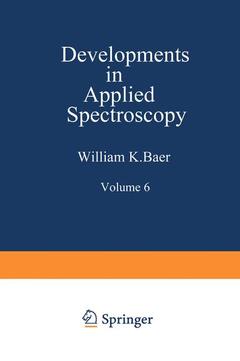Description
Developments in Applied Spectroscopy, 1968
Volume 6 Selected papers from the Eighteenth Annual Mid-America Spectroscopy Symposium Held in Chicago, Illinois May 15-18, 1967
Developments in Applied Spectroscopy Series, Vol. 6
Authors: Baer William K., Perkins Alfred J., Grove E. L.
Language: English
Subject for Developments in Applied Spectroscopy:
Approximative price 52.74 €
In Print (Delivery period: 15 days).
Add to cart
Publication date: 05-2013
403 p. · 15.2x22.9 cm · Paperback
403 p. · 15.2x22.9 cm · Paperback
Description
/li>Contents
/li>
Volume 6 of Developments in Applied Spectroscopy presents a collection of twenty-eight selected papers from those that were pre sented at the Eighteenth Mid-America Symposium on Spectroscopy held in Chicago, May 15 to 18, 1967. In general, the papers selected by the editors are those of the symposium type and not those papers pertaining to a specific research topic that one expects to be sub mitted to a journal. Not all of the submitted papers were included. Some revisions could not meet the deadline and others were not accepted based on the advice of the reviewers. It is the opinion of the committee that this type of publication has ·an important place in the literature. The Mid-America Symposium is sponsored annually by the Chicago Section in cooperation with the Cincinnati, Detroit, Indianapolis, Milwaukee, Niagara Frontier, and St. Louis Sections of the Society of Applied Spectroscopy, and the Chicago Gas Chromatography Group. Although the Mid-America is often thought of as a regional meeting, its attendees and authors generally come from all parts of the United States and Canada. Both applied and theoretical principles were provided in sessions on X-ray, emission, atomic-absorption, nuclear magnetic resonance, infrared, Raman, nuclear-particle, and gamma ray spectroscopy; activation analysis; and gas chromatography. In addition, there were symposia on absorption spectra of biologically significant molecules; the structure of ice, water, and aqueous solu tions; air and water pollution analyses; and the practical application of statistics.
X-Ray Spectroscopy.- Comparison of Methods of Standardization of X-Ray Data.- X-Ray Emission Quantitation of Trace Elements in Biomedical Research.- Determination of Element Localization in Plant Tissue with the Microprobe.- Procedures for the Study of Biological Soft Tissue with the Electron Microprobe.- Emission-Flame-Atomic—Absorption Spectroscopy.- Recent Advances in Analytical Emission Spectroscopy.- Recent Developments in Atomic Absorption and Flame Emission Spectroscopy.- Spectrographic Analysis of Inhaled Air Pollutants in Lung Tissue.- Statistical Applications.- What Can Be Detected.- Statistics Help Evaluate Analytical Methods.- Optimization of Analytical Methods Using Designed Experiments.- Nuclear Applications.- Some Recent Developments in Organic Scintillators.- Accelerator Systems for Activation Analysis—A Comparative Survey.- Spectroscopy of Biologically Significant Molecules.- Spectroscopic Studies of Molecular Interaction in DNA Constituents.- Coordination Properties of Magnesium in Chlorophyll from IR and NMR Spectra.- Near Infrared Spectroscopy in Structural Problems of Biochemistry.- Infrared Spectroscopy of Carbohydrates in Water (1600 to 900 cm-1).- Structure Studies of Ice, Water, and Aqueous Solutions.- Nuclear Magnetic Resonance Studies of Water Structure.- Proton Magnetic Resonance Studies of Water Structure.- The Frequency Distribution of Ice by Neutron Scattering.- Structures of Ice and Water as Investigated by Infrared Spectroscopy.- Pollution Studies.- A Comparative Study in Eutrophication.- The Analysis of Trace Constituents in Water by Spectroscopic Methods.- A Comparison of Trace Elements in Natural Waters, Dissolved versus Suspended.- Application of Spectroscopy and Chromatography in Water Quality Analysis.- Application of Atomic Absorption Spectroscopy in a Water-Pollution Control Program.- Gas Chromatography.- Application of Gas Chromatography in the Petroleum Industry.- Gas Chromatography in the Study of Pollution.- The Application of Gas-Liquid Chromatography to the Analysis of Lipids.
© 2024 LAVOISIER S.A.S.




